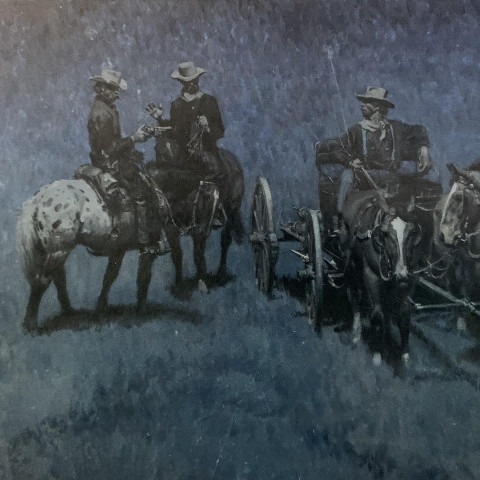For more than half a century, the illustrations and paintings of Harold Von Schmidt were familiar to the American public. His work appeared in the Saturday Evening Post, Sunset, Cosmopolitan, American and other magazines for 20 years, beginning in 1925.
He also illustrated Willa Cather's novel, Death Comes to the Archbishop, and was commissioned in 1960 to design the Pony Express commemorative stamp for the United States postal service.
Born in 1893 in Alameda, California, Von Schmidt was orphaned at five. He was raised by his grandfather and an aunt who encouraged his interest in art. As a young man, he spent his summers working as a lumberjack, cowpuncher and construction worker.
After two years' study with F.H. Meyers at the California College of Arts and Crafts, Von Schmidt did his first cover design in 1913 for Sunset magazine. While attending the San Francisco Art Institute* from 1915 to 1918, he became art director at the Foster and Klein advertising agency. He also made paintings for the Navy in World War I.
Von Schmidt was a member of the United States rugby team in the 1920 Olympics. That year, he and artists Maynard Dixon, Roi Partridge, Judson Starr and Fred Ludekens set up their own agency. He came East in 1924 to study at the Grand Central School of Art in New York City with Harvey Dunn, a former student of Howard Pyle.
During World War II, Von Schmidt was an artist-correspondent for King Features Syndicate and the air force.
He continued to produce non-commercial work, as well as illustrations. He did twelve paintings of the Gold Rush for the California governor's offices, and 5 Civil War paintings for the United States Military Academy at West Point, New York.
Harold Von Schmidt was a founder of the Famous Artists School in Westport, Connecticut.
He died in 1982.
Von Schmidt was a member of the Artists Guild, Artists Guild of the Author's League of America, and Society of Illustrators. His work may be seen at the California State Capitol, Sacramento; Montana Historical Society, Helena; National Cowboy Hall of Fame, Oklahoma City; United States Air Force Academy, Colorado Springs; and the United States Military Academy, West Point, New York.
Source:
Michael David Zellman, Three Hundred Years of American Art

